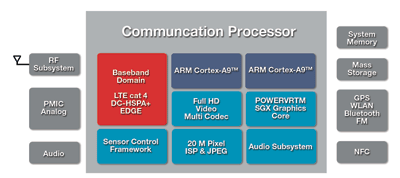Managing power for mobile gaming in smartphones
A number of factors affect power consumption and its consequences
BY JUSSI LEMILAINEN
Vice President, Communications Processor Platforms
Renesas Mobile
www.renesasmobile.com
Battery life is a consistent complaint among mobile device users. Although power demands increase daily, there are technical reasons why it’s difficult to extend battery life. The newest spike in power demand comes from mobile gaming where multiple power-hungry functions run simultaneously: high-speed graphics, mobile broadband connections and radio connections.

A Renesas communications processor for smartphones inside the MP5232 platform uses a number of techniques to minimize power consumption, including a high level of integration and the use of a 28nm process.
Not only are the Nintendo 3DS and the Sony PS Vita popular, but smartphones are becoming games devices as well. The new version of Microsoft Windows mobile will allow people to log on and play their Xbox games with other users.
There are of course short-term fixes. If you don’t mind your slender iPhone becoming bulky, use a case that doubles as a battery or a portable USB battery charger. These, however, don’t address the central problem mobile devices use a lot of juice and require frequent charging.
There are a number of factors affecting power consumption and its consequences. In the case of smaller, portable devices, one of the key challenges is thermal management. Reducing the temperature is an advantage not only because it conserves the power in the device, but also because this preserves the device itself. Overheating will not only damage the short-term performance of a device as it slows down to avoid thermal runaway, but it may affect components within it, causing longer-term issues with performance.
This issue is, of course, compounded by higher data rates. Essentially the more data you want a machine to process at speed, the worse its power consumption. Now consider that gaming is a popular growth area for mobile devices. The intense, immersive graphics and sound, and multiplayer environments, require a high-speed broadband network connection pack a power punch. Compounding the issue is the desire for an email application or Facebook running in the background. This means maximum throughput is required, leading to higher clock frequencies, and more heat and so the cycle continues.
The first thing a design architect can offer is a thermal simulation. This enables a manufacturer to assess the temperature limitations and emissions for each component and to test them in GSM, 3G, and LTE environments. Thermal software management can be built to monitor for battery charge as well as temperature in the light of safety limits.
Other hardware issues can come into play. For example, something as basic as a PCB can be a key heat spreader in a smartphone, USB dongle, or miniPCIe card, so its floor plan needs to take thermal elements into account. Mechanical design rules can help avoid having hotspots under a component. In larger devices such as laptops, the air flow and heat distributors can ensure efficient cooling.
Our latest communications processor for smartphones (which combines an applications processor and a cat-4 triple-mode LTE modem on a single die) inside the MP5232 platform uses a number of techniques to minimize power consumption, including a high level of integration and the use of a 28-nm process. The smaller the technology the smaller the dynamic power consumption. We also applied advanced power domain partitioning; only turning on those parts that are needed for a particular use case and a sophisticated clocking architecture to reduce the power used. In addition, we use a mix of autonomous low-level hardware control and software to manage the system level power control.
The smaller the consumer device, like a smartphone, the more difficult it is to route the heat somewhere productive. This is where ASIC and particularly digital baseband design makes sense, with the ability to switch off some power domains to minimize leakage. Clock controls inside the chips have an impact on the power consumption of the digital baseband, and a gated clock in idle mode reduces the overall power consumption. It is also desirable to use an optimal silicon geometry and process together with low-cutoff battery technology to optimize the power consumption. Choosing the right process is a trade-off between maximum performance and reduced leakage. The expected process corners, how the manufacturing tolerances vary, also need to be considered in the overall system design.
One of the great ironies in the technologist’s life is that end users have never had more demands, for both longer battery life and increased multitasking, whether in games or streaming video. It’s up to the device designers and technologists to fulfill the conflicting wishes. ■
Advertisement
Learn more about Renesas Electronics America





